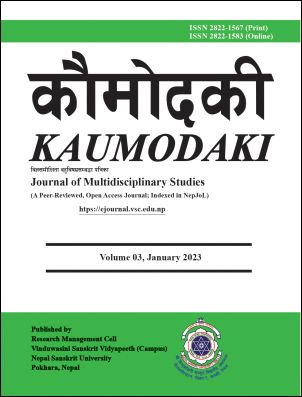Rasa Analysis of Poems in Shastri First Year
DOI:
https://doi.org/10.3126/kdk.v3i1.52094Keywords:
Adbhuta, aesthetic, anubhava, asthayibhava, karuna, rasa, vibhavaAbstract
Literature gets created mainly due to the creator’s desire of evoking his/ her own aesthetic emotions (rasas) and wish to share with and impart similar experience upon readers. This paper has applied and analyzed randomly the selected three poems prescribed in Shastri first year compulsory English course of Sanskrit University, from the perspective of the Eastern aesthetic rasa theory of Bharat. Critical analysis of poems within the theoretical frameworks of rasa theory is the basic approach of the research. The finding shows that Karuna (sadness), Sringar(love), Raudra/Krodha (anger), Bhaya (fear), Vismaya (disgust), Advhuta (amazement) are realized in the poems. Though none of the selected poems evokes Hasya rasa, yet every poem does have one or more rasas: none is devoid of the rasa. The research indicates that teaching fundamental features of all rasas to university students is essential and it would enable students to understand and analyze a literary text well. This paper will make its readers feel this need when they go through the analysis.
Downloads
Downloads
Published
How to Cite
Issue
Section
License
This license enables reusers to distribute, remix, adapt, and build upon the material in any medium or format for noncommercial purposes only, and only so long as attribution is given to the creator.




